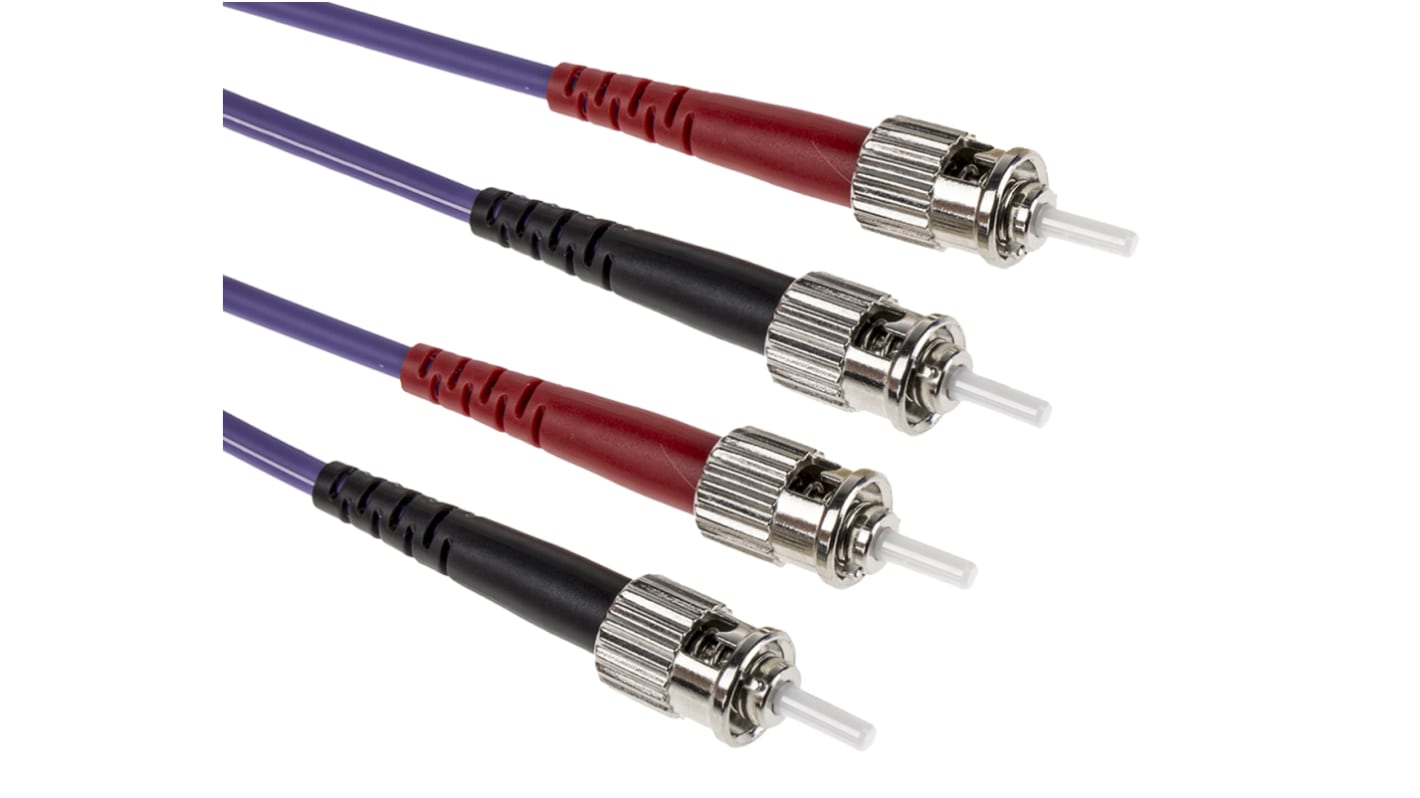RS PRO ST to ST Duplex Multi Mode OM3 Fibre Optic Cable, 50/125μm, Purple, 1m
- RS Stock No.:
- 536-6490
- Distrelec Article No.:
- 304-04-716
- Brand:
- RS PRO

Bulk discount available
Subtotal (1 unit)*
£13.28
(exc. VAT)
£15.94
(inc. VAT)
FREE delivery for orders over £50.00
In Stock
- 165 unit(s) ready to ship
- Plus 8 unit(s) ready to ship from another location
Need more? Click ‘Check delivery dates’ to find extra stock and lead times.
Units | Per unit |
|---|---|
| 1 - 14 | £13.28 |
| 15 - 49 | £12.49 |
| 50 + | £11.80 |
*price indicative
- RS Stock No.:
- 536-6490
- Distrelec Article No.:
- 304-04-716
- Brand:
- RS PRO
Specifications
Technical Reference
Legislation and Compliance
Product Details
Find similar products by selecting one or more attributes.
Select all | Attribute | Value |
|---|---|---|
| Brand | RS PRO | |
| Length | 1m | |
| Connector 1 | ST | |
| Connector 2 | ST | |
| Propagation Mode | Multi Mode | |
| Terminated/Unterminated | Terminated | |
| Core Diameter | 50/125µm | |
| Sheath Colour | Purple | |
| Cable Construction | Duplex | |
| Fibre Type | OM3 | |
| Maximum Operating Temperature | +60°C | |
| Attenuation | 0.3 dB | |
| Minimum Operating Temperature | -20°C | |
| Sheath Material | Low Smoke Zero Halogen (LSZH) | |
| Standards Met | IEC 60332-1, IEC 61300-3-4, IEC 61574 | |
| Select all | ||
|---|---|---|
Brand RS PRO | ||
Length 1m | ||
Connector 1 ST | ||
Connector 2 ST | ||
Propagation Mode Multi Mode | ||
Terminated/Unterminated Terminated | ||
Core Diameter 50/125µm | ||
Sheath Colour Purple | ||
Cable Construction Duplex | ||
Fibre Type OM3 | ||
Maximum Operating Temperature +60°C | ||
Attenuation 0.3 dB | ||
Minimum Operating Temperature -20°C | ||
Sheath Material Low Smoke Zero Halogen (LSZH) | ||
Standards Met IEC 60332-1, IEC 61300-3-4, IEC 61574 | ||
- COO (Country of Origin):
- GB
RS Pro Fibre Optic Patch Cable Assemblies
Our RS Pro OM3 and OM2 optical fibre patch cords allow for new VCSEL based hardware and old legacy LED based hardware to co-exist over your system. They are considered the pinnacle of multimode fibre systems.
Features and Benefits
• Low insertion loss
• Materials compliant to 2011/65/EU
• Patch cable, 50 / 125 μm
• Duplex patch lead 50 / 125 μm
• LSOH sheath 3 mm
• MTRJ as Mini Zip version
• OM2 (orange) and OM3 (purple) fibre quality available
• Split length 15 cm ±5 cm
• Materials compliant to 2011/65/EU
• Patch cable, 50 / 125 μm
• Duplex patch lead 50 / 125 μm
• LSOH sheath 3 mm
• MTRJ as Mini Zip version
• OM2 (orange) and OM3 (purple) fibre quality available
• Split length 15 cm ±5 cm
Typical Applications
• Used in 10 Gigabit, Ethernet, Fast Ethernet and FDDI networks
• Suitable for use in Local Area Network applications
• The optical fibres support a wide range of communications protocols such as Token Ring, video and voice services
• Commonly used in Telecom communications
• Suitable for use in Local Area Network applications
• The optical fibres support a wide range of communications protocols such as Token Ring, video and voice services
• Commonly used in Telecom communications
How does Fibre optic cable work?
Fibre optic cable works through carrying communication signals using pulses of light generated by small lasers orlight-emitting diodes (LEDs). The cable consists of one or more strands, similar in size to a human hair. The centre of each strand is called the core, this core is the pathway for light to travel. The core is surrounded by a layer of glass that reflects light inward to avoid loss of signal and allows the light to pass through bends in the cable.
Note
Each patch cable has a test certificate and is provided with an ID number
Related links
- RS PRO ST to ST Duplex Multi Mode OM3 Fibre Optic Cable Light Blue, 1m
- RS PRO ST to ST Duplex Multi Mode OM3 Fibre Optic Cable Purple, 5m
- RS PRO ST to ST Duplex Multi Mode OM3 Fibre Optic Cable Purple, 2m
- RS PRO ST to ST Duplex Multi Mode OM3 Fibre Optic Cable Light Blue, 500mm
- RS PRO ST to ST Duplex Multi Mode OM3 Fibre Optic Cable Light Blue, 15m
- RS PRO ST to ST Duplex Multi Mode OM3 Fibre Optic Cable Light Blue, 5m
- RS PRO ST to ST Duplex Multi Mode OM3 Fibre Optic Cable Light Blue, 2m
- RS PRO ST to ST Duplex Multi Mode OM3 Fibre Optic Cable Light Blue, 10m
